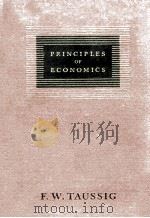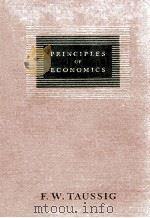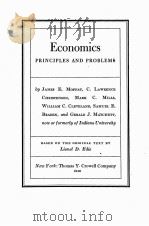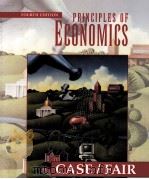《Economics Principles and Problems Fourth Edition》
| 作者 | 编者 |
|---|---|
| 出版 | Thomas Y.Crowell Company |
| 参考页数 | 841 |
| 出版时间 | 1947(求助前请核对) 目录预览 |
| ISBN号 | 无 — 求助条款 |
| PDF编号 | 812537258(仅供预览,未存储实际文件) |
| 求助格式 | 扫描PDF(若分多册发行,每次仅能受理1册) |

PART ONETHE BASIC ECONOMIC PROCESSES1
CHAPTER 1.INTRODUCTION3
Economic activities and human wants4
Utility and consumption4
Standards and planes of living4
Wealth and economic goods5
Objectives of economic activity6
Organization of the means of production8
Forms of economic organization8
Organization of economic life under private-business enterprise10
Private property and freedom of contract10
Operation of business enterprise under private property and contract11
The Sharing of the product:distribution12
Exchange and price13
Business enterprise and the price system13
Simplified view of the operation of individualistic exchange economy15
Economic institutions16
Government in the individualistic economy17
CHAPTER 2.PRODUCTION20
The nature of production20
The growing volume of production21
The factors of production22
Management24
The measurement of production24
Index of production25
Size of the national income26
Netvalue product26
Major branches of production27
Main types of economic fluctuation28
Roundabout production29
Division of labor30
The technology of production32
Standardization33
The automatic machine and quantity production35
Large-scale production36
Coordination of the specialized machine processes38
Science,research,and invention39
Research agencies40
Business research41
Incentives to invention and discovery42
Growth and results of research42
Conservation43
Summary44
CHAPTER 3.THE ORGANIZATION AND DIRECTION OF PRODUCTION47
The individual proprietorship47
The partnership48
The co-operative enterprise49
The government enterprise50
The corporation50
Marketing of corporate securities54
Separation of corporate ownership and control55
Evolution of forms of combination59
Big business and combination61
Suppression of competition65
The role of the promoter66
Successes and failures in combinations and big business66
Technology and large-scale production68
Leadership in big business69
Interlocking directorates70
Financing big business71
Legality of big business73
CHAPTER 4.CONSUMPTION76
The meaning of consumption77
who are the consumers?78
The measurement of consumption79
Differences in consumption81
Growth of consumption82
Changes in consumption82
Main types of fluctuation in consumption84
Budgeting of income87
Consumption a matter of making choices88
Modifications of freedom of choice88
Consumers' choices and the price system90
Consumer Credit92
Guidance of consumers' money choices94
Savings103
Current trends in consumption106
Unfavorable aspects of consumption107
Welfare and consumption109
PART TWOTHE MECHANISM OF EXCHANGE111
CHAPTER 5.MONEY113
Definition of money113
Forms of money114
Deposit currency versus money114
Reasons for the general acceptability of money115
Functions of money116
Qualities of a good money119
Types of money in the United States120
Coinage123
The printing of paper money124
Legal tender124
The monetary system125
Functions of the monetary standard126
Classification of monetary standards127
Technical operation and characteristics of monetary standards127
Advantages and disadvantages of the types of monetary standards130
The controversy over standards134
Criterion for choosing the monetary standard134
Evolution of the monetary standard of the United States135
CHAPTER 6.BANKING INSTITUTIONS AND PROCESSES143
Classes of banks143
Credit Instruments146
Commercial-bank organization146
Functions of commercial banks148
Effects of commercial-bank operations on the balance sheet150
Commercial banks' loans and investments155
Commercial banks and the creation of purchasing power158
Interbank relationships160
Federal Deposit Insurance163
Evolution of the banking system165
CHAPTER 7.THE FEDERAL RESERVE SYSTEM172
Functions of central banks173
Background of the Federal Reserve system174
Administrative mechanism of the Federal Reserve system175
Operations and accomplishments of the Federal Reserve system180
Supervision of bank operations197
CHAPTER 8.PRICE-LEVEL MOVEMENTS200
Factors in the construction of price index numbers201
Types of price-level movements204
Consequences of money-value changes205
Supply of money208
Demand for money208
Determination of the value of money209
An equation of exchange210
Criticisms of the quantity theory of the value of money213
Monetary proposals for regulation of price levels215
Choice of a monetary standard218
CHAPTER 9.FOREIGN EXCHANGE221
The bill of exchange222
Methods of financing foreign transactions222
Bank operations in foreign echange224
Demand and supply of foreign exchange224
Rates of exchange between gold-standard countries224
Triangular and multilateral exchange226
Arbitrage227
Correctives of disequilibrium in the balance of international payments between gold-standard countries227
Rates of exchange between non-gold-standard countries230
Exchange between gold-standard and paper-standard countries231
Exchange between paper-standard countries234
The role of gold movements between paper-standard countries235
Fluctuations of exchange rates between paper-standard countries235
Exchange controls238
Correctives of disequilibrium in the balance of international payments between paper-standard countries239
Policies for stabilization of exchange rates between paper-standard countries241
Forward exchange244
Organization of foreign-exchange markets245
Relative importance of international exchange markets245
The choice of a monetary standard247
PART THREEVALUE AND PRICE251
CHAPTER 10.THE PROBLEM OF VALUE AND PRICE253
Scarcity253
Wants255
Relationship between scarcity and wants256
Three characteristics of economic goods256
Solution of the economic problem257
The phenomenon of price259
Price and value260
The role of price261
Some fundamental questions262
The principle of maximization266
Conclusion268
CHAPTER 11.AN ANALYSIS OF DEMAND271
Demand and consumption271
Utility271
Solution of the problem of consumer choice275
Equilibrium275
A general theory of consumer choice276
Effects of income changes on consumer expenditures278
Effects of price changes on consumer expenditures280
Demand282
Meaning of demand283
Negative slope of the demand curve285
Changes in demand286
Elasticity of demand287
CHAPTER 12.SUPPLY AND DEMAND291
Market situations in economic analysis291
Time periods in economic analysis298
Market supply300
Reservation price301
Changes in supply303
Elasticity of supply303
Competitive market price304
Market-equilibrium price305
Effects of changes in demand and supply306
Monopolistic market price307
CHAPTER 13.THE PRICING PROCESS UNDER COMPETITIVE CONDITIONS311
The sales curve311
Short-run normal price317
Long-run normal price320
Differential costs322
Fluctuating prices323
The normal-supply curve325
Increasing and constant costs326
CHAPTER 14.MONOPOLISTIC COMPETITION AND MONOPOLY329
The sales curve under monopolistic conditions329
Marginal revenue under monopolistic conditions330
Equilibrium under monopolistic competition332
Long-run equilibrium under different conditions334
Price policies under oligopoly335
Decreasing costs336
Prices under duopoly338
Conditions giving rise to monopoly339
Monopoly equilibrium340
Monopoly price policies340
Monopsony342
The effect of monopoly upon price343
CHAPTER 15.PROBLEMS AND PRACTICES IN VALUATION346
Valuation of corporate securities for purposes of investment or speculation346
Valuation of public utilities for purposes of rate making349
Valuation of property for purposes of taxation351
Valuation for miscellaneous purposes352
Price fixing by government353
Government price control after the First World War354
Price control and the Second World War355
Fair and unfair competition358
Price maintenance359
Discriminatory price practices360
Abstract competitive price versus reasonable price364
Continued trend toward monopoly365
Monopoly influences on price policies366
Limits to monopoly influence on prices368
PART FOURFUNCTIONAL DISTRIBUTION OF INCOME371
CHAPTER 16.THE NATIONAL INCOME AND THE PROBLEM OF DISTRIBUTION373
Difficulties in income measurement373
The problem of income distribution380
Methods of income distribution381
Extension of governmental actvity382
Approximate functional distribution of national income383
Distribution of income during the Second World War386
Introduction to the theory of distribution387
The meaning of property rights387
CHAPTER 17.THE THEORY OF WAGES397
The Malthusian doctrine and its setting397
Long-time factors affecting labour supply399
Short-time factors affecting labor supply400
Total labor-supply variations401
The supply of labor to the individual firm or industry402
Migration and economic opportunity403
The supply of labor to the individual firm,and the time factor405
The supply of labor:summary406
The demand for labor and the determination of wage rates407
Who wants labor and why?407
Productiveness of labor in relation to number of workmen408
Reason for decrease in average output per man and possible decrease in the total409
Why the rate of growth in total output changes410
Marginal productivity411
Development of a marginal-productivity curve412
Marginal productivity measured in money414
The marginal value productivity curve in competitive industries415
The marginal value productivity curve under monopolistic conditions415
Conversion of the diminishing marginal value productivity into demand for labor415
Significance of the quantity and order417
The simplified model completed:a labor market418
Allowance for individual differences among workers and working groups420
Further significance of derived demand:Re-emphasis of marginal value productivity422
Allowance for time in determining marginal productivity423
Product price changes and the demand for labor423
Elasticity of demand for labor424
Other factors in marginal productivity and wages426
A summary and a warning426
CHAPTER 18.INSTITUTIONAL ASPECTS OF THE LABOR MARKETS429
Factors affecting size of American labor markets430
Factors affecting character of labor433
Concentration of employment438
Organic nature of human effort439
Wage adjustment and mobility444
Government control of the operation of labor markets448
Industrial accidents and diseases452
Government regulation of the employment contract457
Government encouragement of collective bargaining459
Collective bargaining and trade uinions in the labor markets461
Industrial location of unionism462
Structure of American unionism462
Trade unionism and collective-wage agreements463
Collective bargaining and the theory of wages464
Government as a mediator464
CHAPTER 19.INTEREST468
Use of equipment in the production process468
The savings and investment process470
The nature of interest471
The nature of the interest rate471
Composition of the market interest rate475
The demand for funds477
Sources of the supply of investment funds479
Determination of market rates of interest485
Explicit and implicit interest487
Interest rates and other business conditions487
Interest and the capitalization process489
CHAPTER 20.RENT493
Comparisons of land and equipment493
Merging of land and equipment in economic analysis494
The problem of unearned increment494
Distinction between economic rent and commercial rent495
Differences between rent and interest496
The demand for the uses of land497
The supply of the uses of land497
Differences in land utilization498
The margin of substitution500
The general theory of economic rent501
The law of diminishing returns503
Economic rent as a differential510
Intensive and extensive margins511
The scarcity aspect of the land factor512
Rent and cost of production515
The valuation of land517
Value appreciation and unearned increment518
Conclusion520
CHAPTER 21.THE THEORY OF PROFITS523
Composite nature of profit523
The accountant's concept of profits525
Profits and losses of corporations527
Differences in profits among different concerns528
Profits and dividends530
Profits a residual share531
Sources of pure profit532
Strategic position of enterprisers533
Monopoly profit534
Pure profit as related to risk and ability534
The concept of necessary profit535
CHAPTER 22.THE ROLE OF PROFIT IN PRIVATE-ENTERPRISE CAPTALISM538
Production versus profits538
Effects of production on profits539
Effects of profit expectations on production540
Profit and property valuation541
Cost of profit to the consumer542
Profit during periods of inflation543
Profit and government policy544
The profit motive and social well-being545
PART FIVEINTERNATIONAL ECONOMIC RELATIONS551
CHAPTER 23.PRINCIPLES OF INTERNATIONAL TRADE553
International trade in a free economy553
Comparison of international and domestic trade555
The United States in world trade556
Importance of international trade to the United States558
Geographical distribution of United States trade561
Commodity distribution of United States trade564
Prices and international trade566
Effect of distribution of United States trade564
Prices and international trade566
Effect of distribution of resources on trade567
Trade equilibrium and comparative differences in cost571
Foreign investment and the flow of trade576
The balance of international payments580
CHAPTER 24.PROBLEMS AND POLICIES IN INTERNATIONAL TRADE586
Purpose and nature of the tariff586
Effects of the tariff588
Method of making tariffs590
The case for and against protection591
Recent governmental trade controls599
Current problems in international trade603
Trade policy609
The International Trade Organization611
PART SIXGOVERNMENTAL FUNCTIONS AND FINANCE615
CHAPTER 25.GOVERNMENTAL FUNCTIONS,EXPENDITURES,AND DEBTS617
The role of government in economic affairs617
The productive character of governmental activities618
Increase of governmental expenditures622
Expenditures by function625
Grants-in-aid627
Government economic enterprises629
Public debts631
The federal debt633
Borrowing for war633
The lend-lease program635
Deficit spending and the depression636
State and local debts637
General conclusions regarding public debt638
The federal budget639
CHAPTER 26.THE PRINCIPLES OF TAXATION643
Basic theories of taxation643
The shifting and incidence of taxation647
Shifting,evasion,and avoidance652
Regulatory taxation653
The need for centralized administration654
Requisites of a good tax system655
CHAPTER 27.FEDERAL,STATE,AND LOCAL TAXES660
Importance of taxes for revenue660
FEDERAL TAXES:Income taxes661
Internal excise taxes665
Customs duties665
Estate taxes666
Pay-roll taxes667
War-profits and excess-profits taxes668
STATE AND LOCAL TAXES:General property tax669
State income taxes672
Corporation and business taxes673
Inheritance tax674
Gasoline taxes675
Sales taxes676
Fees677
Special assessments677
PART SEVENTHE ECONOMICS OF RISK681
CHAPTER 28.RISK IN ECONOMIC LIFE683
The nature of economic risk683
Meeting the problem of economic risk685
CHAPTER 29.BUSINESS CYCLES694
Variations and similarities of business cycles694
Duration of business cycles695
Phases of the business cycle698
Some theories of business cycles706
The business cycle an unsolved problem711
Desirability of eliminating cyclical fluctuations711
Stabilization of business712
CHAPTER 30.INSURANCE719
Insurance as a means of sharing economic risk719
Conditions necessary for insurance720
Comparison of private and social insurance724
Life insurance727
Property insurance733
Workmen's compensation insurance735
Unemployment insurance738
Old-age and survivors' insurance741
Conclusion743
PART EIGHTMAJOR ECONOMIC PROBLEMS747
CHAPTER 31.THE MAINTENANCE OF FULL EMPLOYMENT749
The meaning of full employment750
Unemployment in the United States751
Significance of unemployment in labor markets760
Unemployment and the marginal-productivity analysis761
Methods of dealing with unemployment766
The Employment Act of 1946771
Economic problems of full-employment legislation773
CHAPTER 32.PERSONAL DISTRIBUTION OF WEALTH AND INCOME775
Inequality of wealth versus inequality of income775
The problem of inequality776
Some data on inequality776
Effort versus ownership in distribution783
Institutional basis of inequalities in fortune784
The corporation as a property institution786
Diffusion of ownership786
Inequalities of fortune due to unequal privileges787
Inequalities of fortune due to unequal abilities791
Effects of extreme inequality794
Proposed methods of dealing with inequality795
CHAPTER 33.PUBLIC CONTROL799
Major factors affecting public control799
Changes in public control policies800
Economic adaptation801
Economics and government802
Public control in times of national emergency802
Government regulation803
Regulation of banking805
Labor control806
General regulation of business806
Appraisal of antitrust legislation810
Further examples of control811
State regulation813
Local regulation814
The T.V.A.814
Taxation as a means of control814
Public opinion and public control815
Reform816
Conclusion817
INDEX823
1947《Economics Principles and Problems Fourth Edition》由于是年代较久的资料都绝版了,几乎不可能购买到实物。如果大家为了学习确实需要,可向博主求助其电子版PDF文件(由 1947 Thomas Y.Crowell Company 出版的版本) 。对合法合规的求助,我会当即受理并将下载地址发送给你。
高度相关资料
-

- CONSUMER EDUCATION AND ECONOMICS FOURTH EDITION
- 1997 GLENCOE/MCGRAW-HILL
-

- ECONOMICS PRINCIPLES PROBLEMS AND POLICIES
- 1987 MCGRAW HILL BOOK COMPANY
-

- ENERGY PRINCIPLES PROBLEMS ALTERNATIVES FOURTH EDITION
- 1991 ADDISON-WESLEY PUBLISHING COMPANY
-

- ECONOMICS FOURTH EDITION
- 1998 SOUTH-WESTERN COLLEGE PUBLISHING
-

- HEALTH PRINCIPLES AND PRACTICE FOURTH EDITION
- 1964 THE C. V. MOSBY COMPANY
-

- PRINCIPLES OF ACCOUNTING WITH PRACTICE PROBLEMS FOURTH EDITION
- 1939 THE RONALD PRESS COMPANY
-

- CONSUMER ECONOMICS PRINCIPLES AND PROBLEMS SECOND EDITION
- 1959 GREGG PUBLISHING DIVISION
-

- PRINCIPLES OF ECONOMICS VOLUME II FOURTH EDITION
- 1947 THE MACMILLAN COMPANY
-

- PRINCIPLES OF ECONOMICS VOLUME I FOURTH EDITION
- 1946 THE MACMILLAN COMPANY
-

- ECONOMICS PRINCIPLES AND PROBLEMS
- 1946 THOMAS Y. CROWELL COMPANY
-

- PRINCIPLES OF ECONOMICS FOURTH EDITION A RESTATEMENT
- 1947 F.S. CROFTS AND CO.
-

- FOURTH EDITION ECONOMICS
- 1986 PRENTICE-HALL
-

- PRINCIPLES OF ECONOMICS FOURTH EDITION
- 1996 PRENTICE HALL
提示:百度云已更名为百度网盘(百度盘),天翼云盘、微盘下载地址……暂未提供。➥ PDF文字可复制化或转WORD

